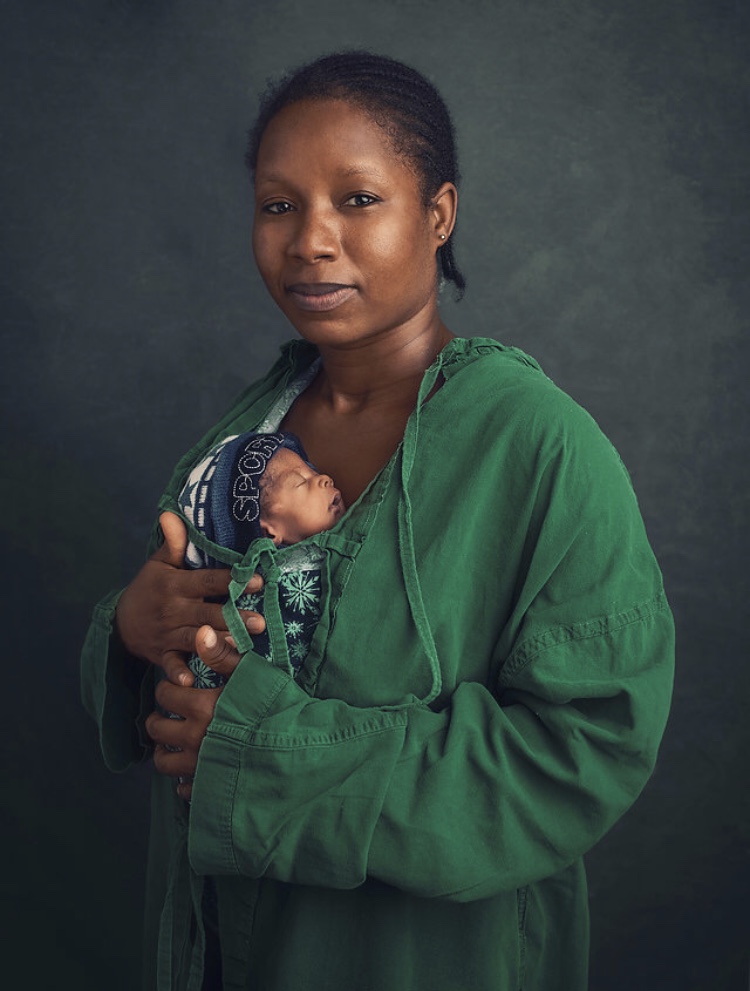On the 18th of December 2017, Flourish Africa in partnership with top child photographer, Ria Solanke visited the new-born unit of the Lagos University Teaching Hospital for a free photo shoot session with some new mothers. This would have been an ordinary shoot except for one thing: the mothers were all kangaroo care mothers. Yes, you heard right, ‘kangaroo mother care’.
The kangaroo mother care (KMC) is a form of nurture given to pre-term babies that involves the baby being placed skin-to-skin as he nests upright against his mother’s chest while wearing only diaper, hat and socks then, both mother and child are held together with a firm cloth.
According to Prof Chinyere Ezeaka, Head of Neonatology Unit, LUTH, and National President of the Nigerian Society of Neonatal Medicine (NISONM), KMC keeps the preterm baby warm, facilitates breastfeeding on demand, improves maternal-newborn bonding, and furthermore, the mother’s heart beat and respiration helpsto maintain the baby’s breathing and heartbeats. Talk about magical!
 Professor Chinyere Ezeaka, Head of the Neonatalogy unit at LUTH
Professor Chinyere Ezeaka, Head of the Neonatalogy unit at LUTH
The Kangaroo Mother Care is affiliated with the way a kangaroo carries her newborn kangaroo called “joey”, which is by nature delivered preterm, it then crawls into the mother’s pouch where it gets fused to the breast for nutrition for about four to five weeks.
KMC was first started in Bogota, Colombia in 1979. The human body’s temperature is stable, as a result, the baby can get all the warmth they need from the mother. The parent’s stable body temperature doesn’t only help to regulate the neonate’s temperature, the closeness that kangaroo care offers both mom and child equally allows for readily accessible breast feeding so that the baby can readily feed and mature.. Thus, KMC ensures physiological and psychological warmth , readily available breastfeeding with improved bonding.

Mrs Tijani with one of her triplets with whom she administers kangaroo mother care
This form of care has been recommended worldwide by the World Health Organization (WHO), and other international and national health agencies as the standard form of care for premature babies who are defined as babies born before 37 weeks. This is in response to the large numbers of premature babies dying globally, and the challenges due to lack of incubators, manpower and stable electricity. The Federal Ministry of Health adopted this method for all levels of care in Nigeria, to complement the use of incubators, in order to help reduce our neonatal mortality; and produced a KMC training manual in 2008.
However, many hospitals within the country are still on the brink of implementation making LUTH one of the foremost tertiary hospitals leading the trail on this side of Africa with a dedicated Kangaroo Care Unit to add to the use of incubators in caring for the teeming number of prematures referred to the hospital for specialized newborn care. This is despite the fact that LUTH has one of the largest newborn wards with about the highest number of incubators in West Africa. Prof Chinyere advises that this form of care be urgently cascaded in other parts of the country as it is not only effective but equally economical; as incubators are very expensive, and beyond reach of many health care providers.
At the LUTH newborn unit, the three mothers were met with their preterm babies tied to their chests in the kangaroo care position. The first mother had a baby, the second had given birth to twins while the third mother had given birth to triplets with the babies each taking turns to nestle against their mother— all preterm and administering the skin to skin form of care.
 Evelyn Fajana with her set of twins
Evelyn Fajana with her set of twins
Although fathers and grandmothers can take part in kangaroo care after appropriate hygiene, especially when the mother needs her rest, the mother should be the primary provider of skin-to-skin contact, as only she can breastfeed. Since skin-to-skin contact is basic to early bonding and attachment, it should probably not be done by hospital staff and other surrogates.
In kangaroo mother care, the baby wears a small diaper, socks and a hat which is placed in a flexed (fetal position) with maximal skin-to-skin contact on the parent’s chest. The baby is secured with a wrap that goes around the naked torso of the adult, providing the baby with proper support and positioning, constant containment without pressure points or creases, and protecting from air drafts (thermoregulation). If it is cold, the parent may wear a shirt or hospital gown with an opening to the front and a blanket over the wrap for the baby.
Lagos University Teaching Hospital seems to have pioneered a groundbreaking movement that needs to be practiced by other hospitals in a bid to reduce the high levels of mortality rates of preterm babies , as pre-term babies have less chances of survival due to immature organs and inability to maintain their body temperature; and even where survived, may suffer life long ailments. For a country ranked as the third highest rate in premature births, KMC practice nationwide in Nigeria is highly significant for our progress.

The three mothers with their bundles of joy

The nurses and matrons in charge of the Kangaroo care unit at LUTH
All the photos were taken in their most natural state and Ria Solanke worked her magic to the excitement of the glowing mothers. At time of publishing, all the mothers had been discharged along with their healthy babies.
Photocredit: Ria Solanke



Leave a Reply